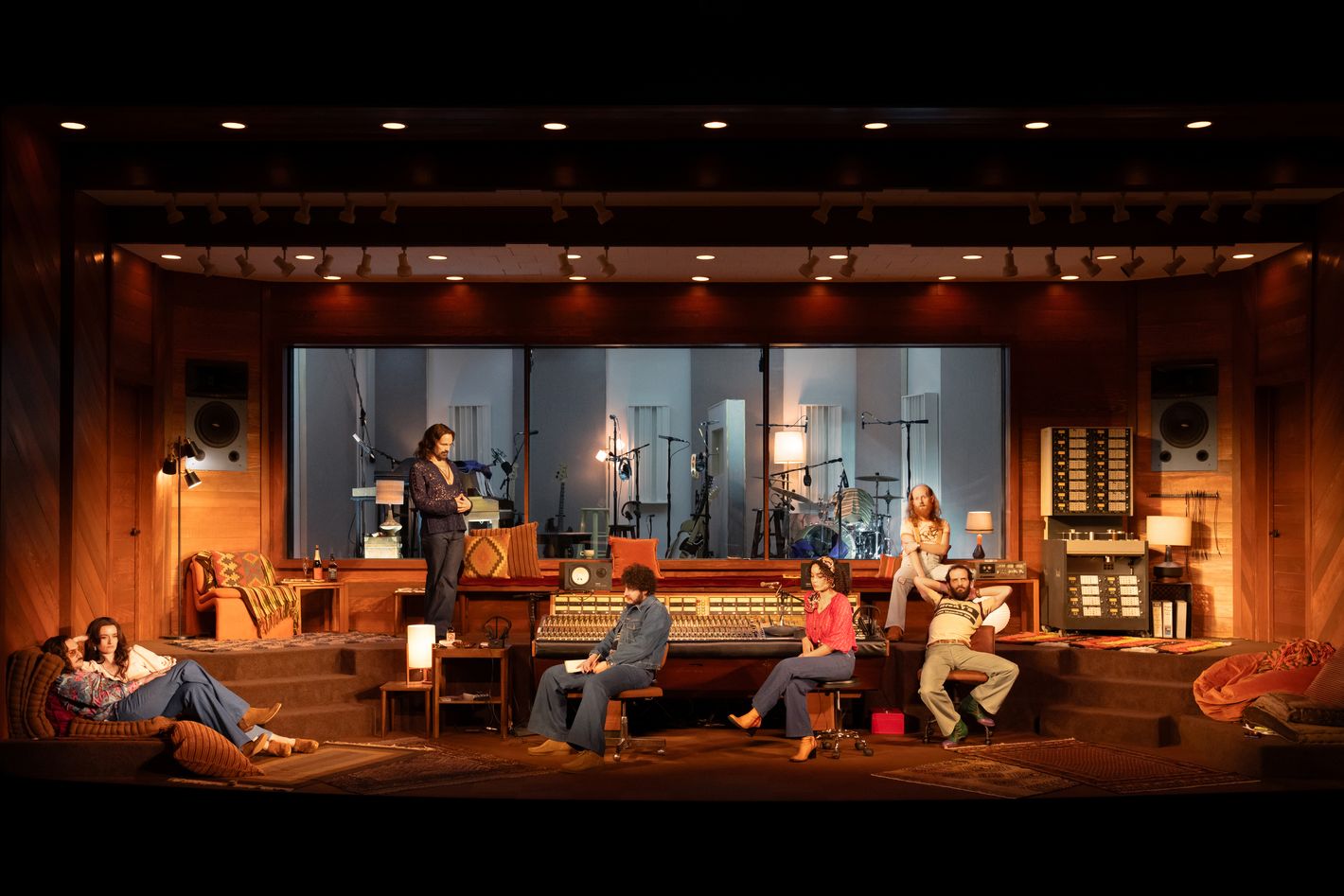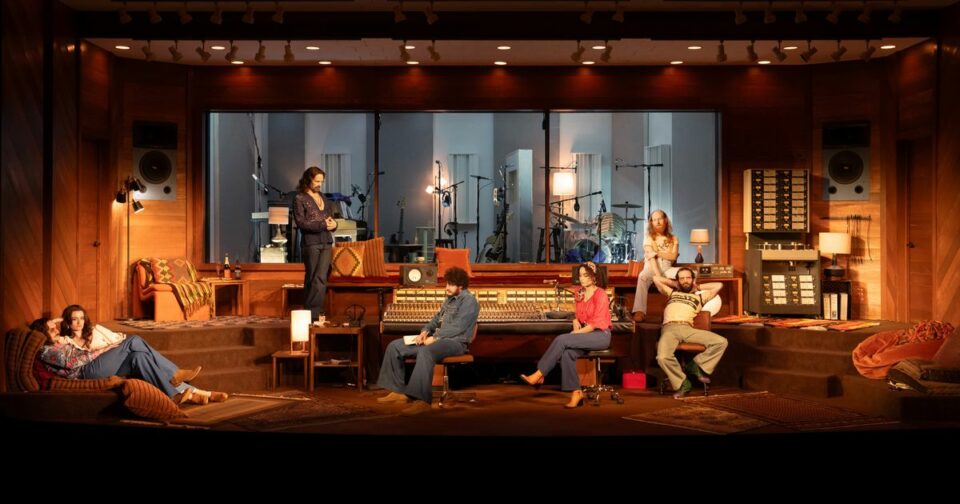
The Act One climax of David Adjmi’s Stereophonic is one of the most exhilarating moments I’ve experienced in a theater in recent memory. We’re in a recording studio in Sausalito, California, evoked in gorgeous detail, down to the smallest dial, the scuzziest beanbag chair and crocheted throw. The year is 1976, and an unnamed band, hovering on the verge of serious fame, is recording an album. They’ve been at it for months. The air is clogged with cigarette smoke and marijuana smoke and tension as viscous as Marmite. The drummer, Simon (Chris Stack), does not want to use a click track, but it’s been 36 takes and he’s still dragging. Diana (Sarah Pidgeon) sings beautifully and has songwriting chops that get stronger by the day, but she’s fragile and defensive and feels constantly under attack from her lead-guitarist boyfriend, Peter (Tom Pecinka), who’s brilliant, creatively domineering … and also fragile and defensive and convinced that he’s constantly under attack from, well, everyone. The wry, aloof vocalist-keyboardist, Holly (Juliana Canfield), has, for the moment, reached a détente with her philosophizing, self-pitying, cocaine-and–Jack Daniels–fueled husband, the bassist, Reg (Will Brill), but hostilities could resume at any moment. The engineers, Grover (Eli Gelb) and Charlie (Andrew R. Butler), just want Simon to use the fucking click track so that they can get the fucking take and everyone can go the fuck to sleep. Then — suddenly, gradually, somehow both — a miracle happens. Take 37 is perfect. The song bursts into driving, dazzling life. People throw down headphones and instruments and grab each other, hugging and hooting and doing stupid dances. Simon howls at the universe, “WE’RE SUCH A GOOD BAND!!!”
Stereophonic is an echo-portrait of Fleetwood Mac and the hard birth of Rumours (Simon, Holly, and Reg are British and played together for years before joining up with Peter and Diana, the Americans). It’s also a stunning feat of scoring by Adjmi — whose hypernaturalistic script captures the ebb and flow of overlapping speech both inside and outside the studio’s sound room — and by director Daniel Aukin and composer Will Butler. Aukin and the show’s stellar cast play Adjmi’s rigorously constructed, deceptively casual prose with as much exactness and audacity as the actors, all playing their instruments live, pour into Butler’s songs: Smart, well-crafted tunes that blend the folk and blues and prog vibes of the ’70s with the soaring indie yearning of Butler’s former band, Arcade Fire. (There’s a cast album on the way.) The show is part concert and part breakup drama, part sound-design marvel (Ryan Rumery is the hero responsible) and part beautifully observed period piece (everyone’s legs look dynamite in Enver Chakartash’s bells and flares, and that lovingly intricate set is by David Zinn). But it’s the thing Adjmi conjures up at the end of Act One that makes Stereophonic such a meaningful and exceptional piece of work: In its bones, it’s a love song, bittersweet and wounded and ferociously loyal, to the act of making art — specifically, art that requires that most exhausting, infuriating, transcendent element: collaboration.
“It’s a torture to need people,” sighs Holly. She and Simon — the Brits who aren’t continuously neck deep in substances — pride themselves on keeping their composure. Simon is the manager and the designated group “dad,” and Holly has the kind of great posture, posh vowels, and naturally regal mien that all the slumming in the world can’t tarnish. But no one in the band is actually okay. They’re all broken, all frightened, all experts in hurting themselves or others or both. But there is something they’re capable of, even called to, amidst the constant raging of egos and reopening of wounds. “I WANNA PLAY MUSIC!” Peter bellows as he stomps from the studio’s control room, where people are still passing around the enormous coke bag and bitching about the broken coffee machine, into the sound room: the temple, the sacred space where things get serious, where everyone suddenly turns from a fucked-up human into a necessary part of a whole.
Plenty of art has been made about the artist as egomaniacal monolith, as genius or tyrant or lonely freak. But Adjmi is looking at something more complex and contradictory — that ineffable thing that pulls a bunch of egos together. The torture and the elation of needing people: Music has it, and theater has it. And anyone who’s thrown themselves into either knows that the same project, the same people, can somehow leave you more battered and drained than you thought possible while also being, as Diana whispers, “the best thing that ever happened” to you.
Right from the title, Adjmi has built into his play this fixation on the harmonies and discords of collaborative creation. Stereophonic sound comes at you from more than one source, blended by the ear and the brain to form a greater whole. That’s the task for the show’s seven actors: Both on instruments and as instruments, they’ve got to weave together individual lines of a precisely built score, and tempo and blend are everything. This is the great trick of high naturalism: To sound the most “real” takes the most careful listening, the most painstaking dedication to style. Adjmi’s script is orchestrated down to the beat — pauses, overlaps, shifts in intonation all noted (one of my favorite stage directions: “proleptic apology”). Language like this takes an ensemble of athletes, along with a great deal of trust — and the show’s transfer from Playwrights Horizons has only given Aukin’s extraordinary company more time to grow together. No one misses a beat, from Brill’s itchy, writhing, slurring, somehow still strangely sweet mess of a bassist (just wait for his mind-blown effusion on houseboats) to Butler’s cheerfully bizarre assistant engineer — his lack of room-reading skills is one of the show’s great entertainments, and the band members’ repeated inability to remember his name is one of its small, hilarious heartbreaks. Canfield gives the outwardly cool Holly gorgeous depths — it’s devastating to hear her, enraptured, tears in her eyes, describe the sex scene from Don’t Look Now as beautiful “because you know it’s coming from grief” — and Stack expertly turns Simon into that guy who’s at once the most lovable and least readable in the room. He seems like the peacemaker, the caretaker, the one who’s there to cheer you up with a bump from the bag and a tickle — but there’s also a distance in him, a cost that’s been paid, a mountain of words unsaid.
As the quasi Lindsey Buckingham and Stevie Nicks figures, Pecinka and Pidgeon have to generate the churning, molten emotional core of the play, and both their chemistry and the sharp edges of their portrayals have only grown since the show’s first run. In contrast to her phenomenal voice, Pidgeon has found something a little uglier in Diana as a character, and it works: It’s all too possible, especially given the teams that we tend to run toward automatically these days, for the exacting, damaged Peter to become the show’s villain. Just listen to the audience gasp when, after the band lays down an absolutely smoking recording of one of Diana’s songs, Peter, stone-faced and toneless, hits her with: “It’s good but … your ego is getting in the way and you need to decide if you’re gonna be a mediocre songwriter or push it to the next level.” Yet it’s crucial that we don’t assign bad guys and good guys in a show like this. Peter — to whom Pecinka completely commits, giving him terrible hardness, immense hurt, and bravely daring to be anything but likable — has got to be as human as Diana, as right and as wrong, as sinned against as sinning. Pidgeon and Pecinka have been nimbly messing around with the dials of their characters’ relationship like Grover at his soundboard, and have found a dynamic that feels marvelously complicated, a rich, sad place where it’s no easy task to point to a singular victim.
And as for Grover — the character is the secret heart of the show, hidden in plain sight at center stage, as we concentrate on the colorful artists behind the glass wall. Gelb quietly crafts a long, aching arc with the suffering, aspiring, not-as-cool-as-he’d-like-to-be engineer. He’s funny, he’s lost, and he’s also every inch an artist: dedicated, ambitious — ultimately, whether he likes it or not, both a perfectionist and a believer. Grover, along with everyone else in this smelly, volatile studio, could shout along with Reg when, at the climax of a ganja-assisted revelation, he declares, “I want to live in art.” It’s not really a joke — it might even be a tragedy. Or maybe it will be the best thing that ever happened.
Stereophonic is at the John Golden Theatre.
Related
- How to Write a Fake Rock Song
- The Best Theater of 2023
Sara Holdren , 2024-04-20 06:01:32
Source link


